If you’re a beginner and WordPress user and wondering how to learn SEO, this guide is for you.
We’ll show you how to optimize web pages to rank higher in search results.
The best way to learn SEO is by doing. Ready for a hands-on tutorial?
Then, let’s get started with How to Learn SEO.
First, we’ll begin by defining SEO.
In This Article
What is SEO?
Search engine optimization (SEO) entails creating content that satisfies users and ranks well.
This process includes 3 stages.
Planning: Because search engines display results in response to search queries (keywords), knowing which keywords you want to rank for is part of SEO.
Creating: Each web page should be focused on a main topic (keyword). Good content makes the main topic clear to users and search engines.
Optimizing: Once your content is created, optimizing your pages and website is crucial. This process helps Google understand your content better and rank it for relevant keywords.
When you produce quality content that satisfies searchers, you can expect the prize: free traffic from Google and other search engines.
3 Things to Know About Search Engine Rankings
Before we get hands-on, it helps to understand a few things about how search engines work.
Discovering: Search engines use bots to find and follow links online. This crawling activity is one of the primary ways they discover web pages.
Sitemaps also help search engines find new pages. For this reason, Google recommends that every website have a sitemap.
Showing up in Google results: Once Google discovers your page, it will analyze it and decide whether to index it.
Indexed pages display in search results. Non-indexed pages don’t.
High-quality content: Quality is the most important ranking factor for web pages, and Google’s search algorithms are honed to detect quality.
Poor quality (or duplicate) pages may be left unindexed by Google.
Knowing these 3 things will help you understand the following steps.
Now, let’s discover how to learn SEO.
How to Learn SEO
The easiest way for WordPress users to learn SEO is to use an SEO plugin. A quality SEO plugin will analyze your pages and show you how to improve your SEO.
In the process, you’ll learn everything you need to know about optimizing web pages for improved rankings.
We recommend All in One SEO (AIOSEO). This plugin is beginner-friendly and comprehensive.
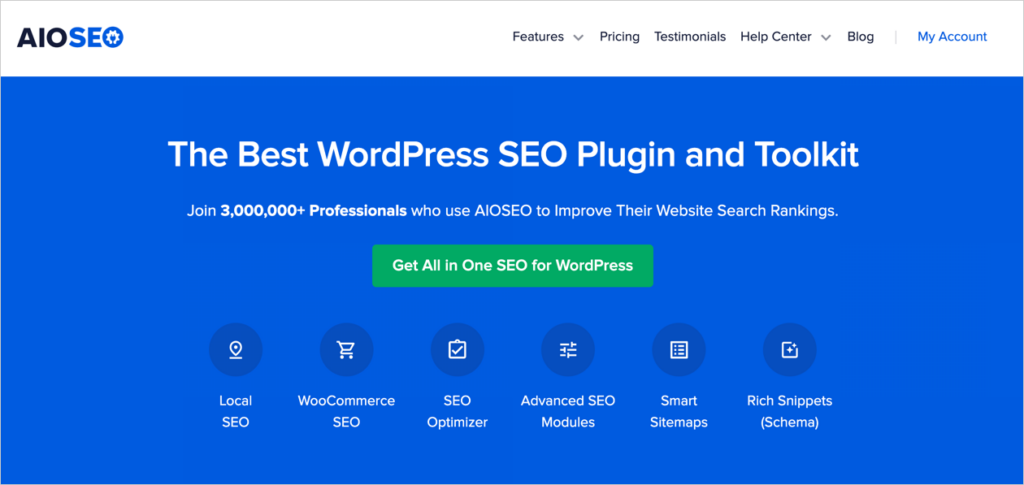
All in One SEO is an established plugin with thousands of 5-star reviews on WordPress.org. Over 3 million people are using the plugin.
Your first step in how to learn SEO is to install the plugin.
Step 1: Download and Install All in One SEO (AIOSEO)
After you download and install All in One SEO (AIOSEO), a setup wizard will walk you through a few steps.
Step 2: Get Sitemaps
The plugin will instantly generate sitemaps for you, following Google’s exact specifications.
These sitemaps are 100% maintenance-free. Every time you modify or publish content, All in One SEO (AIOSEO) will update your sitemaps so Google is aware of new pages.
This is the first step to get your content in search results.
A sitemap is a list of URLs on your website. Google recommends that websites have 2 sitemaps: an XML sitemap, which is a complete list of URLs, and an RSS sitemap, which is a short list of recently published or modified content. AIOSEO generates both types of sitemaps.
Step 3: Learn How to Submit Sitemaps to Search Engines
Next, we recommend that site owners submit their sitemaps to Google and Bing.
This simple process lets the search engines know your sitemap exists and helps them discover your web pages.
If you want your content to reach audiences in the Russian Federation, you’ll also want to submit your sitemaps to Yandex.
Follow these instructions.
With your sitemaps submitted, you’re ready to optimize your homepage.
So make sure you’re logged into the WordPress editor.
Step 4: Learn How to Optimize Your Homepage
In the WordPress admin bar, go to AIOSEO » SEO Analysis.
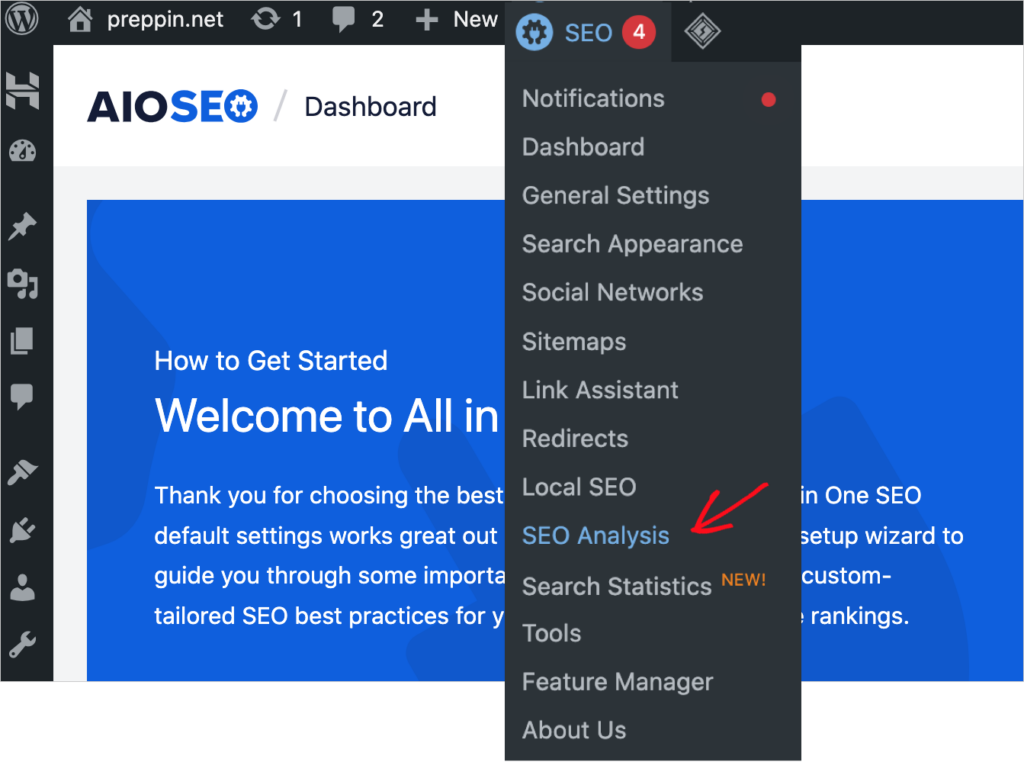
Now, you’ll see an SEO score for your homepage.
Scroll down, and you’ll find the Complete SEO Checklist. This lists
- Good Results
- Important Issues
- Recommended Improvements.
Clicking on an Important Issue will expand it and reveal instructions.

You’ll see your SEO score increase as you take the recommended action steps.
With your homepage optimized, let’s turn to the rest of your web pages.
Step 5: Learn How to Optimize Individual Web Pages
While you’re still logged into WordPress, navigate to a page or post that you want to optimize.
Click the AIOSEO button at the upper right to open the AIOSEO sidebar.
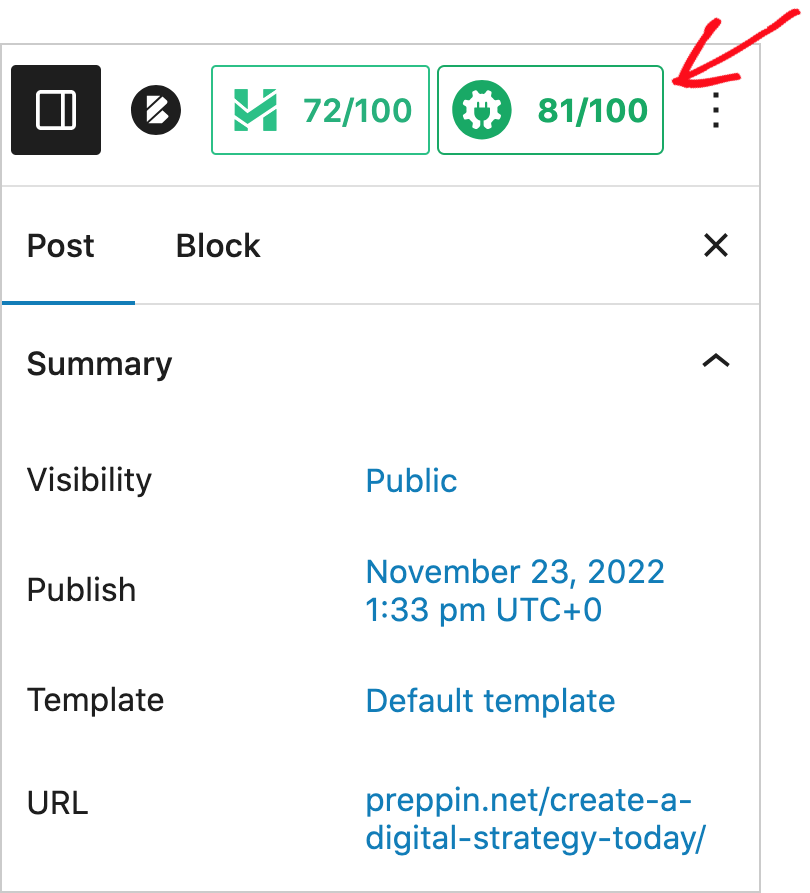
Then click General at the top of that sidebar.
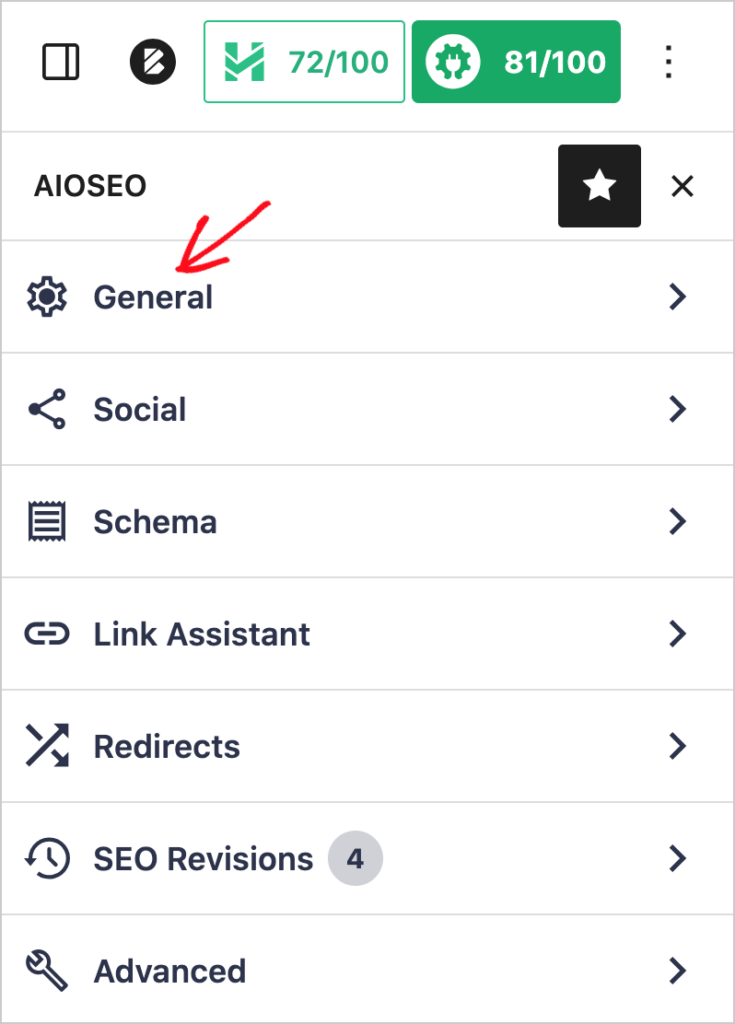
Now you’ll see several clickable items, including:
- Edit Snippet
- Focus keyphrase
- Basic SEO
- Readability
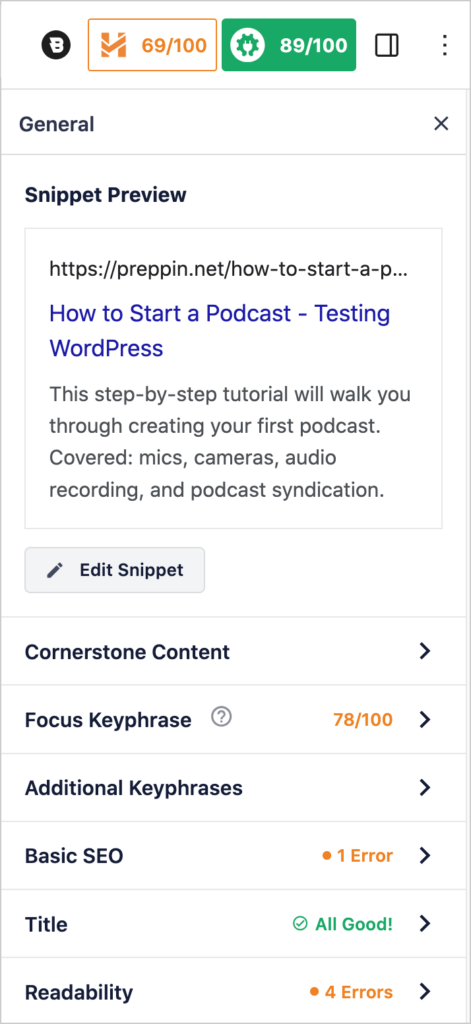
Let’s start with Edit Snippet.
Learn How to Edit a Snippet
Once you click on Edit Snippet, you’ll see a preview of your page in Google Search.
And you’ll see a field where you can edit your title (also called a title tag) and your description (called a meta description).
If you want to keep your title from being too long (and truncated in search results), keep it to 60 characters. Likewise, keep your meta description to 160 characters for the same reason.
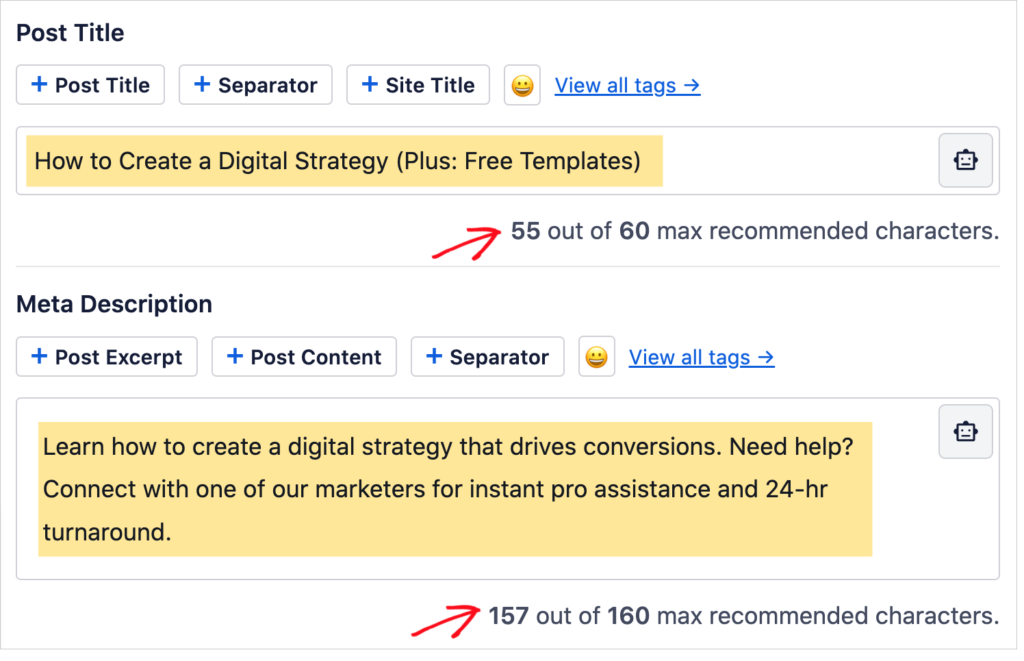
To optimize your title and meta description:
- Include your focus keyphrase
- Make them precise and descriptive
- Keep them within character limits
Now, let’s move on to Focus Keyphrase.
Learn How to Use a Focus Keyphrase
In the AIOSEO sidebar, click on Focus Keyphrase.
Each web page should have a main topic. In SEO, we call this the focus keyphrase. (Other terms are focus keyword or target keyword.)
The first step is to tell AIOSEO your focus keyphrase for the page.
In our example, we’ll use the keyphrase “digital strategy.”
Simply enter your focus keyphrase in the blank space and click Add Focus Keyphrase.

Now All in One SEO will check to see if your focus keyphrase is present in your:
- Title
- Meta description
- URL
- First paragraph
- Some subheadings
- Image alt text
If your focus keyphrase is missing from any of these areas, you’ll be prompted to add it.
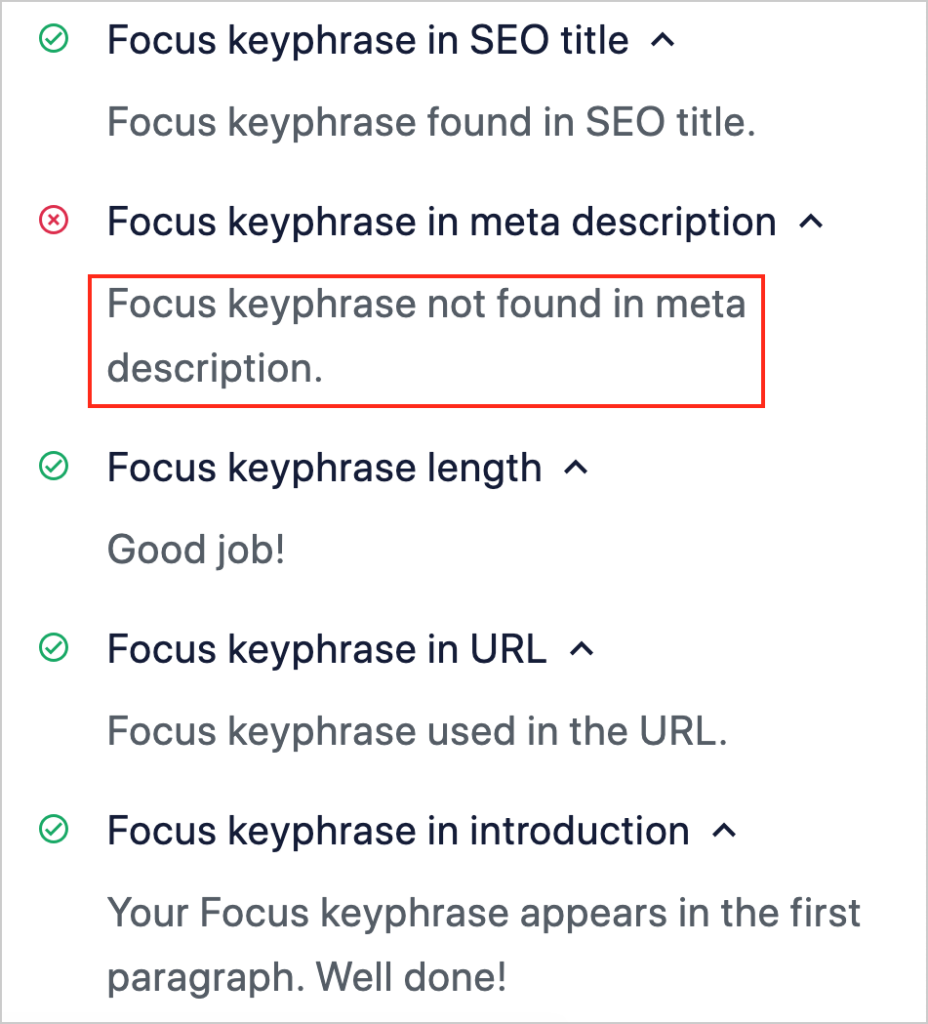
This focus keyphrase check ensures that your main topic is clear to readers and to search engines.
Alt text is a text that describes an image. WordPress provides a field for you to add alt text to images. Search engines read alt text to understand image content.
Learn to Optimize Readability
Now, let’s return to the sidebar and click Readability. Readability measures how easy it is to understand your page content.

Remember that quality content is a top-ranking factor; clear prose can help your page rank and engage readers.
AIOSEO’s readability feature also includes recommendations for making your content scannable. This is a type of formatting that helps engage readers.
As you act on AIOSEO’s Readability recommendations, you’ll see your SEO score increase.
Learn to Apply Schema Markup
Schema markup is code that helps Google understand your content and rank it for relevant keywords. This code also makes your web pages eligible to be displayed as rich snippets.
AIOSEO includes a schema generator. This gives you a click-button way to apply schema without learning code.
Read our guide to learn how to apply schema markup.
We’re confident you’ll agree that using a schema generator is the easiest way to learn about and apply schema markup.

Step 6: Learn About Internal Linking
Internal links are an often overlooked aspect of SEO. And yet, adding internal links can boost your traffic and rankings.
Two ways to use internal links to boost SEO are to find and fix orphan pages and add more links pointing to your most important product or service pages.
Both of these tasks are made easy for beginners in All in One SEO, thanks to Link Assistant.
Open the AI-powered Link Assistant, and you’ll get a list of prioritized pages to work on. The Assistant will also recommend specific links to add.

Keyword Research for Beginners
Quality is the #1 ranking factor for content. And quality content begins with a topic.
In SEO, the main topic of your page is called a keyword. (WordPress users often use the phrase focus keyphrase or focus keyword. Target keyword is a synonymous term.)
We’ve seen how the AIOSEO plugin will teach you to optimize your keyword (focus keyphrase) use.
To rank well, you’ll also need to:
- Create quality content that serves search intent.
- Choose keywords that are easy to rank for.
We recommend this beginner’s guide to keyword research. It will teach you what you need to know about creating content that attracts and satisfies users.
You’ll also learn about the role of keyword research tools like Ahrefs and Semrush.
So, your plan for how to learn SEO should include the basics of keyword research.
How to Learn SEO: Intermediate Topics
Once you’re optimizing your pages for improved rankings and choosing topics well, you may wonder how to move beyond the basics.
These articles will help you grow your SEO knowledge and learn intermediate tactics.
- 7 SEO Secrets Used by the Pros to Grow Revenue
- Topic Clusters: the Secret Weapon of SEO Pros
- Referring Domains vs. Backlinks: What’s the Difference (Plus: SEO Impact)
- How to Monitor the Impact of Google Algorithm Updates in WordPress
Understanding Types of SEO
You may have heard the terms on-page SEO or off-page SEO.
These are terms marketers use to refer to different types of SEO activities.
- One-page SEO refers to actions taken to optimize individual web pages.
- Off-page SEO refers to actions taken on other websites to influence the rankings of one’s site. Examples include a small business creating a Google Business Profile and getting listed in online directories.
- Technical SEO: This term typically refers to professional SEO activities that require specialized knowledge. Examples of technical SEO may be creating custom schema markup and optimizing website loading speeds.
SEO professionals often specialize in a niche, such as international SEO, e-commerce SEO, or recovering from Google penalties. These specialty areas may also be referred to as types of SEO.
Bonus Tips on Measuring Results
Once you’ve mastered SEO basics, you’ll naturally want to measure results.
This is where Google’s free tools come in.
- Google Analytics: This industry staple provides countless metrics and enables users to customize reports to track conversions, ad performance, and revenue details. Try out the MonsterInsights plugin for easy access via the WordPress editor.
- Google Search Console: The GSC dashboard will identify technical issues with indexing or crawling your site and send you a related email alert.
The Elite version of AIOSEO includes Search Statistics, which displays your Google rankings in the WordPress editor.
Q&A on How to Learn SEO
Now that you know how to learn SEO, you probably have some remaining questions.
We’ve answered some of the most common questions on learning SEO. But if you don’t see your question here, please add it to the comments below this article. We’d be delighted to be of assistance.
Can I learn SEO on my own?
Yes, you can learn SEO on your own. WordPress users can use an SEO plugin, like All in One SEO (AIOSEO), to learn specific ways to improve their rankings. This is the best way to learn SEO fundamentals.
Next, bookmark the AIOSEO blog and YouTube channel. These resources will help you learn new SEO skills and increase your knowledge.
Is SEO hard to learn?
The fundamentals of SEO are not hard to learn. There’s no need, for example, to know code. And, thanks to modern content management systems (CMSs) like WordPress and Drupal, optimizing your pages is intuitive.
Using an SEO plugin like All in One SEO shortens the learning curve and simplifies SEO basics. Drupal users can use modules to do the same.
That said, like all disciplines, SEO has advanced levels of specialization. For instance, some SEO professionals specialize in speed optimization or multilingual SEO and need coding skills to be successful.
What is the fastest way for WordPress users to learn SEO?
The fastest way for WordPress users to learn SEO is to use a plugin like All in One SEO. The plugin will analyze your pages and guide you through steps to improve your SEO.
As you take action, you’ll be learning SEO.
What is technical SEO?
Technical SEO is a term that marketers use to denote advanced SEO work. For instance, working on multilingual SEO, optimizing JavaScript for search engines, or speed optimization may require coding knowledge, so these tasks are sometimes categorized as technical SEO.
Other forms of technical SEO include managing SEO for a website redesign, troubleshooting WordPress multisite SEO issues, log file analysis, and edge SEO.
What are meta tags in SEO?
Meta tags in SEO are snippets of text that appear in your website’s HTML code. Invisible to site visitors, these tags help search engines understand the formatting and content of a page. In this way, meta tags may help your content rank for relevant keywords.
Examples of meta tags include those that identify a page’s author, title, description, character set, viewport, and theme color. Facebook OG tags and Twitter cards are also examples of meta tags.
Other meta tags, like noindex or canonical tags, give search engines directives related to indexing and duplicate content.
How to Learn SEO: Next Steps
Now that you’ve learned the fundamentals of search engine optimization, what’s next?
Below are some additional resources to help you expand your SEO knowledge.
- A Simple SEO Tutorial for Beginners
- SEO vs. Social Media: How Do Their Roles Differ in Digital Marketing?
- What is Scannability and How Can You Use It to Improve Content?
- How to Combine Email Marketing and SEO to Increase Revenue
- Word Count for SEO: Does it Matter?
- Referring Domains vs. Backlinks: What’s the Difference?
As you progress in learning, your SEO efforts result in higher rankings and more traffic.
To learn more about search engine optimization, subscribe to our YouTube Channel.
Also, follow us on X (Twitter), LinkedIn, or Facebook to stay in the loop.
Disclosure: Our content is reader-supported. This means if you click on some of our links, then we may earn a commission. We only recommend products that we believe will add value to our readers.

